If you have a symptom of shortness of breath or even a known lung or heart problem, your medical professional might have used a pulse oximeter. It is a small clamp-like painless, and noninvasive device that affixes conveniently to your finger, earlobe, nose, foot, or even toe – utilized to check the volume of oxygen carried in the body.
The pulse oximeter makes use of a cold light source that radiates light through the fingertip, making the tip appear to be red. By measuring and analyzing the light from the light source that passes through the finger, the device is able to identify the percentage of oxygen in the red blood cell. It evaluates the changes in light absorption in oxygenated or deoxygenated blood coming from your cardiovascular system.
Oxygen Saturation (SpO2)
Hemoglobin is an iron-containing protein tied to red blood cells and composed of all the oxygen available. It is responsible for transporting oxygen from lungs to other parts of the body, where the oxygen can be used by other organ cells. Oxy-hemoglobin (HbO2) is the bright red hemoglobin that is a combination of hemoglobin and oxygen from the lungs.
Generally, a single hemoglobin molecule carries approximately four molecules of oxygen. Going with this ratio, 1000 molecules of hemoglobin can carry 4000 oxygen molecules. During the readings, if they together were carrying 3600 oxygen molecules, then the oxygen saturation level bring down to 90% and/or similar ratio can be considered (1).
The oxygen saturation is specified as the ration of oxy-hemoglobin to the total volume of hemoglobin present in the blood. The blood oxygen level ranges from 75 to 100 mm Hg – An oxygen saturation level of 95 to 100 percent is considered healthy, whereas, a level of 92 percent or below indicates potential hypoxemia or deficiency in oxygen reaching tissues in the body.
While having oxygen saturation below this temporarily is not believed to cause damage, repeat or consistent instances of lowered oxygen saturation levels may be damaging. Insufficient saturation can cause a range of adverse health conditions—including chest pain, shortness of breath, and increased heart rate.
Pulse Rate
Your pulse rate is an estimation of the number of times your heart contracts per minute. According to the Mayo Clinic, normal pulse rate values for adults range from 60 to 100 beats per minute (bpm). In general, a lower heart rate at rest implies more efficient heart function and better cardiovascular fitness.
For some people, a pulse rate below 60 bpm indicates abnormally slow heart action, also known as bradycardia. Bradycardia can cause a number of problematic symptoms—including fainting, fatigue, chest pains, and memory problems.
The Purpose of Pulse Oximeter
You can expect a simple, quick, and secure indicator of your heart rate and your oxygen saturation level by display readout. There are no needles and no pain associated with oximetry use. The readings play an essential role in helping patients adjust their oxygen flow while working out, participating in social activities, or spending time with family at home or away (2).
The measured amount provides your physicians and nurses an idea of tracking the efficiency of therapy and respond rapidly to the condition related to your particular situation. The results also help you to determine if you need to receive supplemental oxygen.
The device can be used to monitor oxygen levels in various conditions like Asthma, Pneumonia, Lung disorders or any breathing issues, Anemia, Chronic obstructive Pulmonary Disease COPD), Heart disorders, during or after surgeries, etc.
For people with COPD, asthma, or other lung disorders who want to keep active, the quality of their pulse oximeter is incredibly important, particularly for them who are physically active or experiencing frequent drops in oxygen levels. For instance, individuals with asthma can take advantage of personal oximeters to determine the severity of attacks and heightening.
It constantly delivers results within a 2-percent variation regardless of what it truly is. If your reading was 82 percent, maybe your true oxygen saturation level may be anywhere from 80 to 84 percent. Nevertheless, the quality of the waveform and assessment of the individual to be actually looked at.
It does not mean that higher SpO2 and pulse rate measurements are always a sign of health problems. Your heart rate can be expected to increase during exercise, and oxygen saturation may decrease slightly.
Factors such as movement, temperature, nail polish, long, artificial nails, or if your fingers are not clean, can impact the accuracy. Some medical centers also use non-reusable strip probing that wraps around your finger, nose, or the toe.
If you are having it at home, it might possible that the device could give a faulty reading or be used incorrectly, prompting a patient to seek care unnecessarily. The device can either be reused or may then be disposed of.
Get your Pulse Oximeter and keep your family safe in this testing time.
For COVID-19 infection
There has been a sudden spike in the demand of the device in the wake of the ongoing coronavirus pandemic. As the shortness of breath is considered one of the key symptoms of Coronavirus infection, people are using a pulse oximeter to detect the level of oxygen in their blood.
The pulse oximeter can definitely aid to detect the oxygen levels in the blood. But you should not depend solely on the readings as far as coronavirus infection is concerned. Because the oxygen level may decrease to a dangerous level only when the condition becomes severe. It comes long after the initial symptoms like high fever and dry cough.
So, a pulse oximeter is not an accurate machine to determine the COVID19 infection. Get in touch with your healthcare system as soon as minimal symptoms observed.
